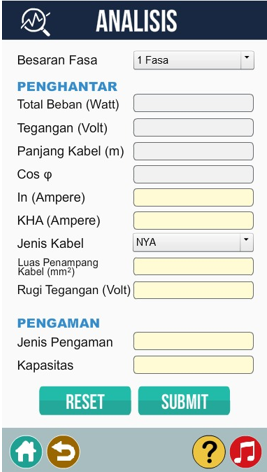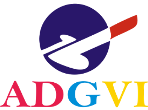Development of Freeware-Mobile Application for Learning Electrical Installation in Vocational High Schools

Downloads
The study aims to design and develop a freeware application for electrical installation planning analysis. This research is categorized as development research, adopting the RAPID Application Development (RAD) model. The data collection process in this study involved a series of methods, including direct observation of the learning process, in-depth interviews with potential users, and the distribution of structured questionnaires to relevant respondents. The analysis of the collected data was carried out using a quantitative descriptive method, which aimed to describe and interpret numerical data related to the performance and acceptance of the developed application. The overall results of this study indicate that the designed and developed freeware application, as a learning media for electrical installation planning analysis, demonstrates highly satisfactory performance and falls into the "Very Good " category. Specifically, the evaluation of the application's functionality aspect showed a success rate of 100%, indicating that all designed features and functions operate according to the expected specifications. Similarly, the assessment of the user interface aspect also reached a percentage of 100%, implying that the application's interface design is intuitive, easy to use, and overall provides a positive user experience. In addition, in terms of material and media feasibility, it produces "Highly Feasible". The application is determined to effectively incorporate electrical installation planning content pertaining to the learning outcomes of determining cable sizes and circuit breaker capacity. Consequently, this freeware application has significant potential to become an effective learning media in enhancing the understanding and skills of students and practitioners in the field of electrical installation planning.
Downloads
[1] D. Triantini and N. Yuniarti, “The Innovation of Technology Utilisation in Distributing Employee by Vocational Secondary School Career Centre,” in Journal of Physics: Con-ference Series, IOP Publishing Ltd, Mar. 2021. doi: 10.1088/1742-6596/1833/1/012025.
[2] Badan Pusat Statistik, “Tingkat Pengangguran Terbuka Berdasarkan Tingkat Pendidikan, 2024.” Accessed: Mar. 23, 2025. [Online]. Available: https://www.bps.go.id/id/statistics-table/2/MTE3OSMy/tingkat-pengangguran-terbuka-berdasarkan-tingkat-pendidikan.html
[3] R. Syahputra, T. B. Prayoga, and Z. Ma’rufan Chandra, “Media Pembelajaran Berbasis IT,” JOURNAL OF INFORMATION SYSTEMS AND MANAGEMENT, vol. 03, no. 02, 2024, [Online]. Available: https://jisma.org
[4] F. Reinhold, S. Hoch, B. Werner, J. Richter-Gebert, and K. Reiss, “Learning Fractions with and without Educational technology: What Matters for High-Achieving and Low-Achieving Students?,” Learn Instr, vol. 65, Feb. 2020, doi: 10.1016/j.learninstruc.2019.101264.
[5] J. V.D. Wirjawan, D. Pratama, E. Pratidhina, A. Wijaya, B. Untung, and Herwinarso, “De-velopment of Smartphone App as Media to Learn Impulse-Momentum Topics for High School Students,” International Journal of Instruction, vol. 13, no. 3, pp. 17–30, Jul. 2020, doi: 10.29333/iji.2020.1332a.
[6] S. Becker, P. Klein, A. Gößling, and J. Kuhn, “Using Mobile Devices to Enhance Inquiry-based Learning Processes,” Learn Instr, vol. 69, Oct. 2020, doi: 10.1016/j.learninstruc.2020.101350.
[7] Sugianto, A. Sadam Fahrezi, and P. Oetomo, “Electrical Installation Planning in Hospital Building,” 2022. Accessed: Mar. 23, 2025. [Online]. Available: https://ejournal.istn.ac.id/index.php/sinusoida/article/view/1464/965
[8] K. M. Madro’i, S. Supratno, and P. W. A. Sucipto, “Simulasi Perhitungan Kebutuhan Pen-erangan Ruangan dan Penentuan Luas Penampang Kabel Berbasis Sistem Pakar,” Jour-nal of Electrical and Electronics, vol. 4, no. 2, pp. 81–88, 2016.
[9] M. Muskhir, A. Luthfi, H. Effendi, N. Jalinus, A. D. Samala, and V. Slavov, “Can Mobile-Based Augmented Reality Improve Learning in Electrical Circuit Education?,” Interna-tional Journal of Information and Education Technology, vol. 15, no. 3, pp. 595–604, 2025, doi: 10.18178/ijiet.2025.15.3.2268.
[10] Nuraminah, F. Azim, K. Anshari, and U. Urazaliyeva, “Engaging electrical lighting installa-tion classes: Android interactive learning media development with Adobe Animate CC,” Journal of Computer-based Instructional Media, vol. 2, no. 2, pp. 102–117, Oct. 2024, doi: 10.58712/jcim.v2i2.134.
[11] L. C. Juera, “Digitalizing skills development using simulation-based mobile (SiM) learning application,” Journal of Computers in Education, vol. 11, no. 1, pp. 29–50, Mar. 2024, doi: 10.1007/s40692-022-00246-8.
[12] R. Rahmadani, E. D. Suryanto, and M. Affandi, “Development of Android-Based Learn-ing Multimedia for Electrical Lighting Installation Courses in Vocational High School,” in Proceedings of the 6th Annual International Seminar on Transformative Education and Educational Leadership (AISTEEL 2021), 2021, pp. 736–739. doi: 10.2991/assehr.k.211110.172.
[13] S. Mohtar, N. Jomhari, M. B. Mustafa, and Z. M. Yusoff, “Mobile learning: research con-text, methodologies and future works towards middle-aged adults – a systematic literature review,” Multimed Tools Appl, vol. 82, no. 7, pp. 11117–11143, Mar. 2023, doi: 10.1007/s11042-022-13698-y.
[14] B. Curum and K. K. Khedo, “Cognitive load management in mobile learning systems: principles and theories,” Journal of Computers in Education, vol. 8, no. 1, pp. 109–136, Mar. 2021, doi: 10.1007/s40692-020-00173-6.
[15] C. G. Che Kob, S. Kannapiran, and A. Shah, “The Usage of Mobile Learning: Compara-tive Studies among Technical and Vocational Education Students in Selected Universi-ties,” International Journal of Interactive Mobile Technologies (iJIM), vol. 14, no. 05, p. 203, Apr. 2020, doi: 10.3991/ijim.v14i05.13355.
[16] K. Zhampeissova, I. Kosareva, and U. Borisova, “Collaborative Mobile Learning with Smartphones in Higher Education,” International Journal of Interactive Mobile Technol-ogies (iJIM), vol. 14, no. 21, p. 4, Dec. 2020, doi: 10.3991/ijim.v14i21.18461.
[17] A. Mewengkang, O. E. S. Liando, and J. R. Batmetan, “Impact of Mobile Learning using social media platform on Vocational Student’s Achievement Results,” E3S Web of Con-ferences, vol. 328, p. 04003, Dec. 2021, doi: 10.1051/e3sconf/202132804003.
[18] S. Criollo-C, A. Guerrero-Arias, Á. Jaramillo-Alcázar, and S. Luján-Mora, “Mobile Learn-ing Technologies for Education: Benefits and Pending Issues,” Applied Sciences, vol. 11, no. 9, p. 4111, Apr. 2021, doi: 10.3390/app11094111.
[19] I. D. Luptáková, J. Hanuliaková, L. Žido, and P. Bartoš, “M-Learning and Experiential Learning in Vocational Education,” Emerging Science Journal, vol. 8, no. Special Issue, pp. 298–310, Jan. 2025, doi: 10.28991/ESJ-2024-SIED1-017.
[20] M. Churiyah, B. A. Dharma, F. T. P. Adi, and S. A. Muhidin, “Mobile Learning in Voca-tional Education: Tendency Towards Self Regulated Learning,” in Proceedings of the BISTIC Business Innovation Sustainability and Technology International Conference (BISTIC 2021), 2021, pp. 307–314. doi: 10.2991/aebmr.k.211115.045.
[21] R. Fadli et al., “Practicality of Mobile-Based Learning with Project-Based Learning Ap-proach in Electric Motor Installation to Increase Student Learning Motivation,” Interna-tional Journal of Information and Education Technology, vol. 14, no. 8, pp. 1127–1135, 2024, doi: 10.18178/ijiet.2024.14.8.2141.
[22] S. Criollo-C, A. Guerrero-Arias, Á. Jaramillo-Alcázar, and S. Luján-Mora, “Mobile Learn-ing Technologies for Education: Benefits and Pending Issues,” Applied Sciences, vol. 11, no. 9, p. 4111, Apr. 2021, doi: 10.3390/app11094111.
[23] Z. Yu, M. Gao, and L. Wang, “The Effect of Educational Games on Learning Outcomes, Student Motivation, Engagement and Satisfaction,” Journal of Educational Computing Research, vol. 59, no. 3, pp. 522–546, Jun. 2021, doi: 10.1177/0735633120969214.
[24] Sirwan, Nurkhamid, and R. D. Mahande, “The Potential of Indonesia in the Utilization of Mobile Learning in Vocational High School,” in 3rd International Conference on Current Issues in Education (ICCIE), 2018.
[25] R. F. Y. Sinaga and N. Sinaga, “Pengembangan Media Pembelajaran Mobile Learning Berbasis Android Dengan Ispring Suite Pada Mata Pelajaran Instalasi Motor Listrik Kelas XI Jurusan Teknik Instalasi Tenaga Listrik di Smk Swasta Imelda Medan,” JEVTE: Jour-nal of Electrical Vocational Teacher Education, vol. 1, no. 1, p. 40, May 2021, doi: 10.24114/jevte.v1i1.25046.
[26] A. Z. D. Nur Adiya, D. L. Anggraeni, and Ilham Albana, “Analisa Perbandingan Penggunaan Metodologi Pengembangan Perangkat Lunak (Waterfall, Prototype, Itera-tive, Spiral, Rapid Application Development (RAD)),” Merkurius : Jurnal Riset Sistem In-formasi dan Teknik Informatika, vol. 2, no. 4, pp. 122–134, Jun. 2024, doi: 10.61132/merkurius.v2i4.148.
[27] Y. A. Singgalen, “Coastal and Marine Tourism Monitoring System Design using Rapid Application Development (RAD) ,” Journal of Information System Research (JOSH), vol. 5, no. 2, pp. 468–479, Jan. 2024, doi: 10.47065/josh.v5i2.4720.
[28] A. H. Nadzar and E. Supriyadi, “Pengembangan Media Pembelajaran Berbasis Android Database Komponen Listrik,” 2020. [Online]. Available: https://journal.uny.ac.id/index.php/jee
[29] D. Saputra, B. Gürbüz, and Haryani, “Android-based Animation for Chemical Elements and Experiments as an Interactive Learning Media,” J.Sci.Learn, vol. 2021, no. 2, pp. 185–191, 2021, doi: 10.17509/jsl.v4i2.28787.
[30] R. S. Pressman and B. R. Maxim, Software Engineering: A Practitioner’s Approach. New York: McGraw-Hill Education, 2019. [Online]. Available: www.mhhe.com/pressman.
[31] I. W. Djatmiko, Strategi Penulisan Skripsi, Tesis, Disertasi Bidang Pendidikan, 1st ed. Yogyakarta: UNY Press, 2018.
[32] B. Scaddan, Electrical Installation Work. Routledge, 2022.
[33] W. Tribudianti, Instalasi Penerangan Listrik (C3) Kelas XI. Quantum Buku Sejahtera, 2020.
[34] H. Santoso, Instalasi Penerangan Listrik. Bumi aksara, 2020.
[35] A. D. Frayudha, I. R. Pande, and M. B. Juwita, “Implementation of Black Box Testing with the Application of Equivalence Partitioning Techniques in the M-Magazine Android Application at Semen Gresik High School,” Elinvo (Electronics, Informatics, and Voca-tional Education), vol. 9, no. 1, pp. 134–143, Jun. 2024, doi: 10.21831/elinvo.v9i1.70382.
[36] S. Udeshi, P. Arora, and S. Chattopadhyay, “Automated Directed Fairness Testing,” in ASE 2018 - Proceedings of the 33rd ACM/IEEE International Conference on Automated Software Engineering, Association for Computing Machinery, Inc, Sep. 2018, pp. 98–108. doi: 10.1145/3238147.3238165.
[37] D. Wood, Basics Interactive Design: Interface Design. Bloomsbury Publishing, 2019.
[38] W. W. Lee and D. L. Owens, Multimedia-based Instructional Design. Pfeiffer A Wiley Imprint, 2004.
[39] S. M. Alessi and S. Trollip, Multimedia for learning: methods and development, vol. 3. Italy: Pearson, 2001.
[40] Google, “Material Design,” Google. Accessed: May 17, 2025. [Online]. Available: https://m2.material.io/design
[41] F. Eliza et al., “Effective virtual laboratory to build constructivist thinking in electrical measurement practicum,” Indonesian Journal of Electrical Engineering and Computer Science, vol. 34, no. 2, p. 814, May 2024, doi: 10.11591/ijeecs.v34.i2.pp814-824.
[42] R. Fadli et al., “Effectiveness of Mobile Virtual Laboratory Based on Project-Based Learning to Build Constructivism Thinking,” International Journal of Interactive Mobile Technologies (iJIM), vol. 18, no. 06, pp. 40–55, Mar. 2024, doi: 10.3991/ijim.v18i06.47643.
[43] A.-I. Zourmpakis, M. Kalogiannakis, and S. Papadakis, “Adaptive Gamification in Sci-ence Education: An Analysis of the Impact of Implementation and Adapted Game Ele-ments on Students’ Motivation,” Computers, vol. 12, no. 7, p. 143, Jul. 2023, doi: 10.3390/computers12070143.
Copyright (c) 2025 Jurnal Edukasi Elektro

This work is licensed under a Creative Commons Attribution-ShareAlike 4.0 International License.
The Authors submitting a manuscript do so on the understanding that if accepted for publication, copyright publishing of the article shall be assigned to Journal.



















